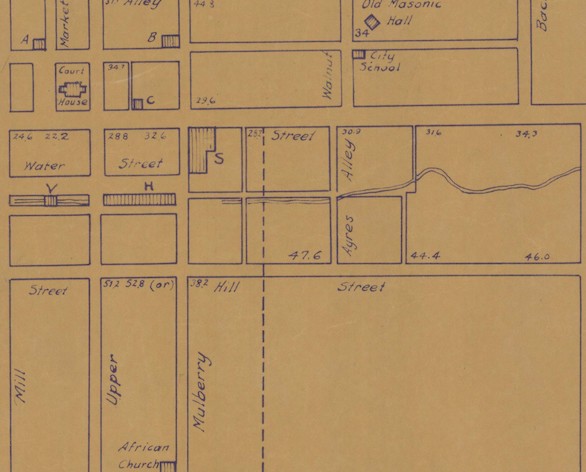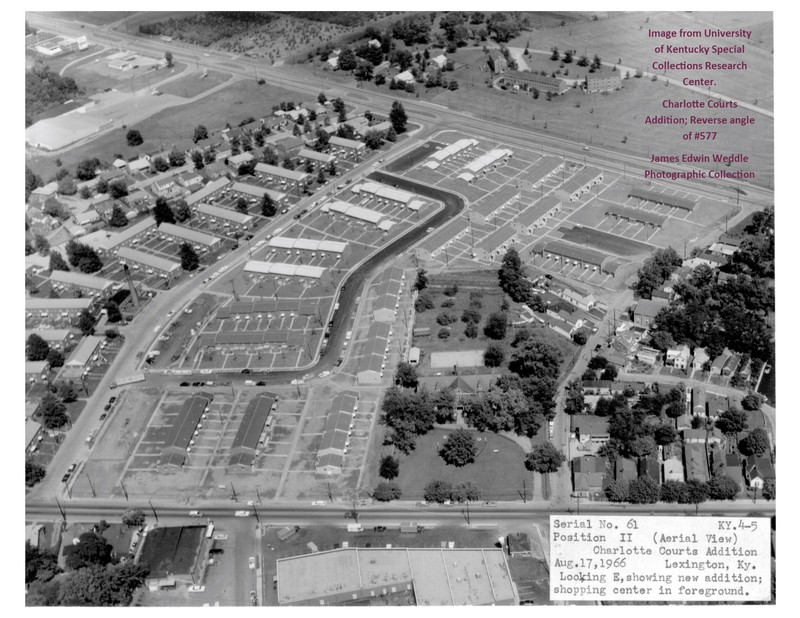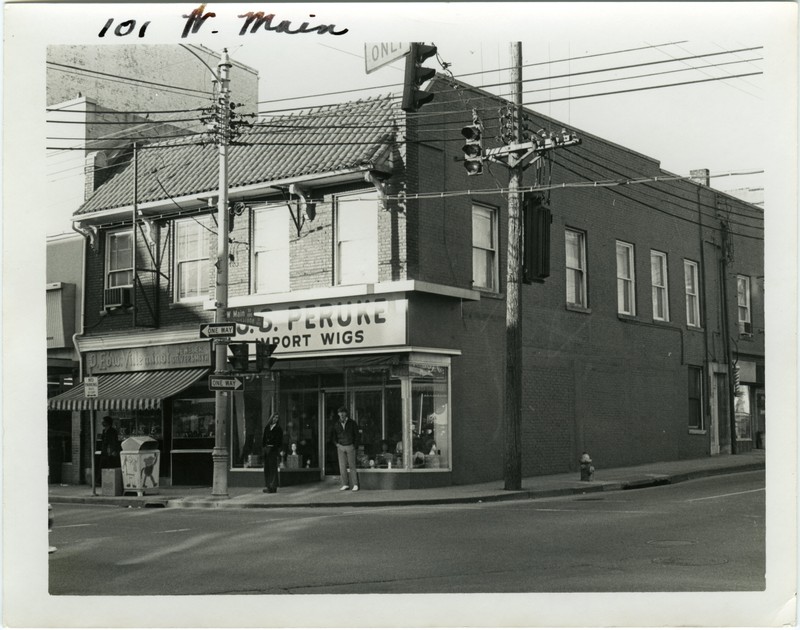Aunt Charlotte's House
Introduction
Text-to-speech Audio
Images
Map of Lexington from 1835, Focused on where Aunt Charlotte's House would have been

Charlotte Court- Housing project named after Aunt Charlotte

101 West Main street. May have been built for John B. Johnson during the early 1830s, this gives an idea of what the buildings around Charlotte's house could have looked like

Backstory and Context
Text-to-speech Audio
Aunt Charlotte was originally from Virginia and was still enslaved when her owners brought her to Lexington in the later part of the 1700s. Once they died she became free and acquired her past owner’s property [1]: "Slavery was an important part of the antebellum economy in the Bluegrass, where slaves made up about one half of the population. Essential to the operation of the area's hemp plantations, slaves also were hired out by their owners for factory work and other jobs. Lexington was a major slave market to the Deep South from the 1830s to the 1850s." [2]
Especially being in the South it was rare for a freed Black woman to own a house and have her own small business: "Only one in forty Blacks resided in an urban place of the slave states in 1790 and by 1860 this proportion had only slightly more than doubled" [7]. She sold baked goods and produce at markets in Lexington to make a living. One day she went to an auction were William “King” Solomon was being auctioned off. Historians believe that Charlotte and Solomon knew each other back in Virginia [1]. He was the town drunkard and was being sold for servitude for nine months. Charlotte bought Solomon for $13 and freed him from servitude: [3] he "became the property of Aunt Charlotte, the free woman of color, setting in motion one of Kentucky’s renowned tales of the past." [5] Thirteen dollars was no small sum in the 1830s; in today's economy that would be about $346. The fact that she outbid medical students for Solomon shows Charlotte's persistence. Afterwards, she gave him a place to stay at her house if he needed it. Some also believe she bought Solomon to help her with laborious tasks around her house like chopping wood [4].
Once Solomon was freed, he went out and got drunk, the exact opposite of what he was supposed to do. Charlotte still opened her house to him, and he stumbled back to her house after a night of drinking and passed out on the front porch [1]. When he woke up the next morning, many people had already died from Cholera. Charlotte decided to leave Lexington for the time being, because she did not want to get infected with the disease [1]. So, when Solomon woke up the next morning, Charlotte was getting ready to leave. To help with the crisis, Solomon started to bury the dead at the Old Episcopal Burial Grounds, which helped to reduce the number of people infected by Cholera in Lexington. Charlotte is really the unspoken hero in the Cholera Epidemic because she is the one who saved Solomon from servitude. If she was not at that auction on that day, Solomon might have gotten Cholera and died with the rest of the victims [2]. He would not have been there to bury the dead and reduced the chances of someone else getting infected. It is not known what happened to Aunt Charlotte after the Cholera Epidemic--although some believe she died from disease [4]. There are not many records, pictures or articles mentioning Aunt Charlotte, but she will be always be remembered in local Lexington history.
In 1939, a housing project was named after her; it was called Charlotte Courts. It was a public housing project for African Americans located on Georgetown Road [6]. The government gave $900,000 for the housing project and it stood for many years, but because of a high crime rate Charlotte Courts was torn down in 1998. The city of Lexington received $19 million for housing projects; they tore it down and built what is now called Arbor Grove [6].
What little is recorded of Charlotte's story hints at the many untold histories yet to be discovered about the lives of free African-Americans in pre-Civil War Kentucky.
Sources
- “Aunt Charlotte and King Solomon,” Notable Kentucky African Americans Database, accessed December 4, 2019, https://nkaa.uky.edu/nkaa/items/show/575.
- “Civil War History: Lexington, Kentucky.” Civil War History: Lexington, Kentucky, www.visitlex.com/idea-guide/civil-war-sites/.
- “Cholera, Part One: King Solomon .” Cholera, Part One: King Solomon (blog). Tales from The Kentucky Room , February 18, 2019. https://www.youtube.com/watch?list=PLG66nrVI0W2Kvwr-oT0JuJfOCawe5pusC&time_continue=408&v=JruPAqR5C9c&feature=emb_title.
- “Cholera, Part Two: The Pie Seller, the Drunk, and the Lady (2018).” Cholera, Part Two: The Pie Seller, the Drunk, and the Lady (2018) (blog). Youtube, February 18, 2019. https://www.youtube.com/watch?v=YcxnINGjbSo.
- Terry, Sam. “MY KENTUCKY: Solomon and Charlotte, an Unlikely Partnership.” Jobe for Kentucky, September 1, 2017. https://www.jpinews.com/2017/0901/my-kentucky-solomon-and-charlotte-an-unlikely-partnership/.
- “Charlotte Court(s) in Lexington, KY,” Notable Kentucky African Americans Database, accessed December 7, 2019, http://nkaa.uky.edu/nkaa/items/show/1622.
- Wilkie, Jane Riblett. "The Black Urban Population of the Pre-Civil War South." Phylon (1960-) 37, no. 3 (1976): 250-62. doi:10.2307/274454.
University of Kentucky Map Library
“Charlotte Court(s) in Lexington, KY,” Notable Kentucky African Americans Database, accessed December 4, 2019, http://nkaa.uky.edu/nkaa/items/show/1622.
https://exploreuk.uky.edu/catalog/xt7sf766515x_28_1
